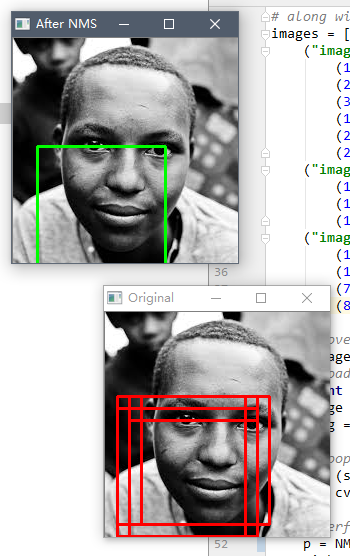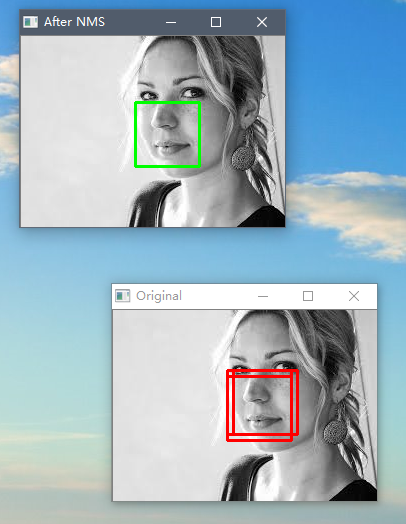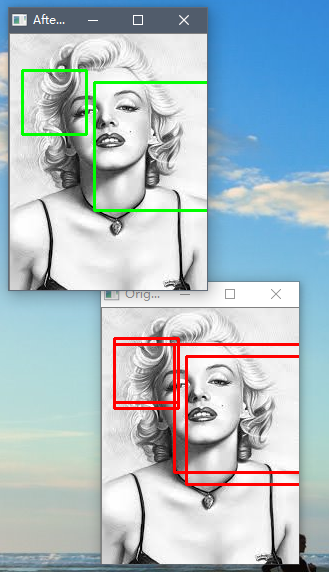机器学习中,使用NMS对框取优
一、NMS实现代码
# http://www.pyimagesearch.com/2015/02/16/faster-non-maximum-suppression-python/ import numpy as np class NMSuppression(object):
def __init__(self, bbs, overlapThreshold = 0.45):
self.bbs = bbs
self.overlapThreshold = overlapThreshold def _check_empty(self):
# return an empty list, if there are no boxes
if len(self.bbs) == 0:
return []
else:
return self.bbs def _check_dtype(self):
# if the bounding boxes integers, convert them to floats (divisions)
if self.bbs.dtype.kind == "i":
self.bbs = self.bbs.astype("float")
return self.bbs def bb_coordinates(self):
# get the coordinates of the bounding boxes
x1 = self.bbs[:, 0]
y1 = self.bbs[:, 1]
x2 = self.bbs[:, 2]
y2 = self.bbs[:, 3]
return x1, y1, x2, y2 def bb_area(self):
# compute the area of the bounding boxes
x1, y1, x2, y2 = self.bb_coordinates()
area = (x2 - x1 + 1) * (y2 - y1 + 1)
return area def calc_ovarlap(self, x1, y1, x2, y2, idxs, last, i, area):
# find the largest (x, y) coordinates for the start of
# the bounding box and the smallest (x, y) coordinates
# for the end of the bounding box
xx1 = np.maximum(x1[i], x1[idxs[:last]])
yy1 = np.maximum(y1[i], y1[idxs[:last]])
xx2 = np.minimum(x2[i], x2[idxs[:last]])
yy2 = np.minimum(y2[i], y2[idxs[:last]]) # compute the width and height of the bounding box
w = np.maximum(0, xx2 - xx1 + 1)
h = np.maximum(0, yy2 - yy1 + 1) # compute the ratio of overlap
overlap = (w * h) / area[idxs[:last]] return overlap def slow_suppress(self):
self._check_empty()
self._check_dtype() # initialize the list of picked indexes
picked = [] x1, y1, x2, y2 = self.bb_coordinates() # compute the area of the bounding boxes
area = self.bb_area() # sort the bounding boxes by the bottom-right y-coordinate of the bounding box
idxs = np.argsort(y2) # keep looping while some indexes still remain in the indexes list
while len(idxs) > 0:
# grab the last index in the indexes list, add the index
# value to the list of picked indexes, then initialize
# the suppression list (i.e. indexes that will be deleted)
# using the last index
last = len(idxs) - 1
i = idxs[last]
picked.append(i)
suppress = [last] # loop over all indexes in the indexes list
for pos in xrange(0, last):
# grab the current index
j = idxs[pos] # find the largest (x, y) coordinates for the start of
# the bounding box and the smallest (x, y) coordinates
# for the end of the bounding box
xx1 = max(x1[i], x1[j])
yy1 = max(y1[i], y1[j])
xx2 = min(x2[i], x2[j])
yy2 = min(y2[i], y2[j]) # compute the width and height of the bounding box
w = max(0, xx2 - xx1 + 1)
h = max(0, yy2 - yy1 + 1) # compute the ratio of overlap between the computed
# bounding box and the bounding box in the area list
overlap = float(w * h) / area[j] # if there is sufficient overlap, suppress the
# current bounding box
if overlap > self.overlapThreshold:
suppress.append(pos) # delete all indexes from the index list that are in the
# suppression list
idxs = np.delete(idxs, suppress) # return only the bounding boxes that were picked
return self.bbs[picked] def fast_suppress(self):
self._check_empty()
self._check_dtype() # initialize the list of picked indexes
picked = [] x1, y1, x2, y2 = self.bb_coordinates() # compute the area of the bounding boxes
area = self.bb_area() # sort the bounding boxes by the bottom-right y-coordinate of the bounding box
idxs = np.argsort(y2) # keep looping while some indexes still remain in the indexes list
while len(idxs) > 0:
# take the last index in the indexes list and add the
# index value to the list of picked indexes
last = len(idxs) - 1
i = idxs[last]
picked.append(i) overlap = self.calc_ovarlap(x1, y1, x2, y2, idxs, last, i, area) # delete all indexes from the index list that have
idxs = np.delete(idxs, np.concatenate(([last], np.where(overlap > self.overlapThreshold)[0]))) # return only the bounding boxes that were picked using the
# integer data type return self.bbs[picked].astype("int")
二、调用测试
#taken from: http://www.pyimagesearch.com/2014/11/17/non-maximum-suppression-object-detection-python
"""
Project parts (taken from the tutorial above):
1. Sampling positive images
2. Sampling negative images
3. Training a Linear SVM
4. Performing hard-negative mining
5. Re-training your Linear SVM using the hard-negative samples
6. Evaluating your classifier on your test dataset, utilizing non-maximum
suppression to ignore redundant, overlapping bounding boxes The sample images in this project are taken from the web (labeled as: no licensing needed for non-comertial use).
""" from nm_suppression import NMSuppression
import numpy as np
import cv2 # construct a list containing the images that will be examined
# along with their respective bounding boxes
images = [
("images/africa.jpeg", np.array([
(12, 84, 140, 212),
(24, 84, 152, 212),
(36, 84, 164, 212),
(12, 96, 140, 224),
(24, 96, 152, 224),
(24, 108, 152, 236)])),
("images/girl.jpeg", np.array([
(114, 60, 178, 124),
(120, 60, 184, 124),
(114, 66, 178, 130)])),
("images/monroe.jpeg", np.array([
(12, 30, 76, 94),
(12, 36, 76, 100),
(72, 36, 200, 164),
(84, 48, 212, 176)]))] # loop over the images
for (imagePath, boundingBoxes) in images:
# load the image and clone it
print "[x] %d initial bounding boxes" % (len(boundingBoxes))
image = cv2.imread(imagePath)
orig = image.copy() # loop over the bounding boxes for each image and draw them
for (startX, startY, endX, endY) in boundingBoxes:
cv2.rectangle(orig, (startX, startY), (endX, endY), (0, 0, 255), 2) # perform non-maximum suppression on the bounding boxes
p = NMSuppression(bbs=boundingBoxes, overlapThreshold=0.5)
pick = p.fast_suppress()
print "[x] after applying non-maximum, %d bounding boxes" % (len(pick)) # loop over the picked bounding boxes and draw them
for (startX, startY, endX, endY) in pick:
cv2.rectangle(image, (startX, startY), (endX, endY), (0, 255, 0), 2) # display the images
cv2.imshow("Original", orig)
cv2.imshow("After NMS", image)
cv2.waitKey(0)
三、效果



机器学习中,使用NMS对框取优的更多相关文章
- paper 126:[转载] 机器学习中的范数规则化之(一)L0、L1与L2范数
机器学习中的范数规则化之(一)L0.L1与L2范数 zouxy09@qq.com http://blog.csdn.net/zouxy09 今天我们聊聊机器学习中出现的非常频繁的问题:过拟合与规则化. ...
- 机器学习中的范数规则化之(一)L0、L1与L2范数(转)
http://blog.csdn.net/zouxy09/article/details/24971995 机器学习中的范数规则化之(一)L0.L1与L2范数 zouxy09@qq.com http: ...
- 机器学习中的范数规则化之(一)L0、L1与L2范数 非常好,必看
机器学习中的范数规则化之(一)L0.L1与L2范数 zouxy09@qq.com http://blog.csdn.net/zouxy09 今天我们聊聊机器学习中出现的非常频繁的问题:过拟合与规则化. ...
- 机器学习中的范数规则化-L0,L1和L2范式(转载)
机器学习中的范数规则化之(一)L0.L1与L2范数 zouxy09@qq.com http://blog.csdn.net/zouxy09 今天我们聊聊机器学习中出现的非常频繁的问题:过拟合与规则化. ...
- 机器学习中模型泛化能力和过拟合现象(overfitting)的矛盾、以及其主要缓解方法正则化技术原理初探
1. 偏差与方差 - 机器学习算法泛化性能分析 在一个项目中,我们通过设计和训练得到了一个model,该model的泛化可能很好,也可能不尽如人意,其背后的决定因素是什么呢?或者说我们可以从哪些方面去 ...
- 机器学习中的算法(2)-支持向量机(SVM)基础
版权声明:本文由LeftNotEasy发布于http://leftnoteasy.cnblogs.com, 本文可以被全部的转载或者部分使用,但请注明出处,如果有问题,请联系wheeleast@gma ...
- 机器学习中的规则化范数(L0, L1, L2, 核范数)
目录: 一.L0,L1范数 二.L2范数 三.核范数 今天我们聊聊机器学习中出现的非常频繁的问题:过拟合与规则化.我们先简单的来理解下常用的L0.L1.L2和核范数规则化.最后聊下规则化项参数的选择问 ...
- 机器学习中的损失函数 (着重比较:hinge loss vs softmax loss)
https://blog.csdn.net/u010976453/article/details/78488279 1. 损失函数 损失函数(Loss function)是用来估量你模型的预测值 f( ...
- 机器学习中的范数规则化 L0、L1与L2范数 核范数与规则项参数选择
http://blog.csdn.net/zouxy09/article/details/24971995 机器学习中的范数规则化之(一)L0.L1与L2范数 zouxy09@qq.com http: ...
随机推荐
- Quartz 定时任务设置某个时间区间每隔一定时间触发的cron表达式
原文:https://blog.csdn.net/yansong_8686/article/details/46991189 Cron表达式 Quartz使用类似于Linux下的Cron表达式定义时间 ...
- Spring整合Disruptor
原文:https://segmentfault.com/a/1190000014469173 什么是Disruptor 从功能上来看,Disruptor 是实现了“队列”的功能,而且是一个有界队列.那 ...
- UICollectionView 相关
当数据不多,collectionView.contentSize小于collectionView.frame.size的时候,UICollectionView是不会滚动的 self.Cov.alway ...
- JVM调优系列:(五)JVM常用调试参数和工具
转自:http://blog.csdn.net/opensure/article/details/46715769 JVM常用调试参数: –verbose:gc在虚拟机发生内存回收时在输出设备显示信息 ...
- 大并发下TCP内存消耗优化小记(86万并发业务正常服务)
转自:http://blog.csdn.net/u010954257/article/details/54178160 最近在做一个大并发服务的测试(目前测到86万,当然有大量长连接,每天打的日志高到 ...
- JAVA使用Marvin在图片中搜索图片
Java对图像的处理框架比较少,目前比较流行的有Jmagick以及Marvin,但Jmagick只能处理图像(上篇Java清除图片中的恶意信息(利用Jmagick)中对Jmagick已做过简略介绍), ...
- HttpSession javax.servlet.http.HttpServletRequest.getSession(boolean arg0)理解
request.getSession()和request.getSession(true)意思相同:获取session,如果session不存在,就新建一个 reqeust.getSession(fa ...
- 将CAGradientLayer当做mask使用
将CAGradientLayer当做mask使用 效果 源码 https://github.com/YouXianMing/Animations // // CAGradientView.h // M ...
- 深入理解java虚拟机(六)字节码指令简介
Java虚拟机指令是由(占用一个字节长度.代表某种特定操作含义的数字)操作码Opcode,以及跟随在其后的零至多个代表此操作所需参数的称为操作数 Operands 构成的.由于Java虚拟机是面向操作 ...
- SpringBoot 使用Swagger2打造在线接口文档(附汉化教程)
原文地址: https://www.jianshu.com/p/7e543f0f0bd8 SpringBoot + Swagger2 UI界面-汉化教程 1.默认的英文界面UI 想必很多小伙伴都曾经使 ...
